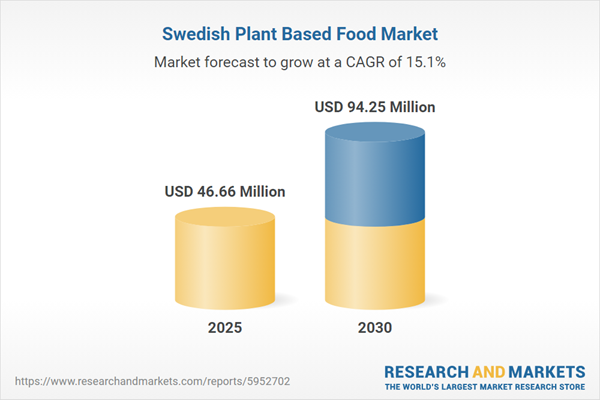The availability of plant-based foods has expanded in Sweden as more people choose them over dairy and meat. People are choosing cruelty-free and environment-friendly food alternatives due to concerns about animal welfare and environmental sustainability. A wider range of plant-based foods that are just as convenient and delicious as their animal counterparts has been made possible by advancements in food technology. This tendency is further accelerated by government assistance in the form of public health campaigns and legislation that favors sustainable agriculture.
Moreover, the Sweden plant-based food market is projected to rise at a significant growth rate. The industry is expected to be affected by changing environmental, and governmental regulations which are anticipated to challenge market growth as well. In addition, the increasing advancements and market developments, including product launches, collaborations, agreements, acquisitions, and other related factors. The market is poised to be dependent on various distribution modes for plant-based foods, such as offline and online channels. Regulations associated with the application verticals are also expected to affect the market trajectory. Following this, with projections of a healthy growth rate, the market is expected to rise steadily with growing vegan food preferences among the people of Sweden.
Sweden plant-based food market drivers
Growing imports of agricultural products.Imports of agricultural products can broaden the scope of plant-based foods available in Sweden and diversify the market. As per the data represented by the International Trade Administration, a total of $25.414 billion in agricultural and associated items were imported by Sweden in 2022, with $275 million coming from the US. This is fueled due to the growing health consciousness among consumers which has led to an increase in demand for fresh, organic, and free-from food products.
Furthermore, growing sustainable eating practices in Sweden has a beneficial effect on the plant-based foods market, which in turn promotes industry expansion and innovation. This trend encourages the further acceptance of plant-based diets and goods, which is in line with Sweden's strong environmental conscience. The Swedish Dietary Guidelines are being modified to accommodate various food cultures and are intended for healthy adults, adolescents, and children two years of age and older. Specific population group recommendations (vegetarians, newborns, and children under two years old, as well as pregnant and lactating mothers) are given individually.
Reasons for buying this report:
- Insightful Analysis: Gain detailed market insights covering major as well as emerging geographical regions, focusing on customer segments, government policies and socio-economic factors, consumer preferences, industry verticals, other sub-segments.
- Competitive Landscape: Understand the strategic maneuvers employed by key players globally to understand possible market penetration with the correct strategy.
- Market Drivers & Future Trends: Explore the dynamic factors and pivotal market trends and how they will shape up future market developments.
- Actionable Recommendations: Utilize the insights to exercise strategic decision to uncover new business streams and revenues in a dynamic environment.
- Caters to a Wide Audience: Beneficial and cost-effective for startups, research institutions, consultants, SMEs, and large enterprises.
What do businesses use our reports for?
Industry and Market Insights, Opportunity Assessment, Product Demand Forecasting, Market Entry Strategy, Geographical Expansion, Capital Investment Decisions, Regulatory Framework & Implications, New Product Development, Competitive IntelligenceReport Coverage:
- Historical data & forecasts from 2022 to 2030
- Growth Opportunities, Challenges, Supply Chain Outlook, Regulatory Framework, Customer Behaviour, and Trend Analysis
- Competitive Positioning, Strategies, and Market Share Analysis
- Revenue Growth and Forecast Assessment of segments and regions including countries
- Company Profiling (Strategies, Products, Financial Information, and Key Developments among others)
The Sweden Plant Based food market is segmented and analyzed as follows:
By Type
- Food
- Meat
- Others
- Beverage
- Milk
- Others
By Source
- Soya
- Legumes
- Coconut
- Wheat
- Peas
- Oats
- Others
By Distribution Channel
- Offline
- Supermarket/ Hypermarkets
- Convenience Store
- Online
Table of Contents
Companies Mentioned
- LiveKIndly
- Orkla
- Nestle
- Paulig Group
- Dava Foods Holding A/S
- Oatly
- Stockeld
- Dug
- Fazer
Table Information
| Report Attribute | Details |
|---|---|
| No. of Pages | 98 |
| Published | December 2024 |
| Forecast Period | 2025 - 2030 |
| Estimated Market Value ( USD | $ 46.66 Million |
| Forecasted Market Value ( USD | $ 94.25 Million |
| Compound Annual Growth Rate | 15.1% |
| Regions Covered | Sweden |
| No. of Companies Mentioned | 9 |









